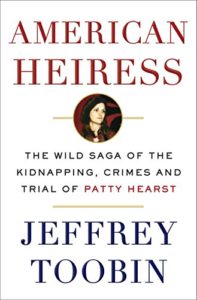
In early 1974, the United States was in turmoil. Richard Nixon was about to be impeached, the Vietnam War was still grinding on, the OPEC Oil Embargo was underway, and an average of 2,000 bombs had been exploded in the country in each of the three preceding years. Then, on February 4, a 19-year-old woman bearing one of the most famous names in the country was kidnapped in Berkeley. Her grandfather was the press lord William Randolph Hearst, a towering figure in the late nineteenth and early twentieth centuries. Patty Hearst, or Patricia as she strongly preferred, was a junior at UC Berkeley. Patricia’s story is brilliantly chronicled in American Heiress by Jeffrey Toobin.
Estimated reading time: 5 minutes
The sensational kidnapping of Patty Hearst
Only the kidnapping of Charles Lindbergh, Jr. could match the sensationalism of Patty Hearst’s seizure from her apartment. Now, more than forty years later, the Hearst kidnapping quickly headlined news stories around the country. It was not just that Patricia’s name was famous. The kidnappers were an unknown and mysterious revolutionary band calling themselves the Symbionese Liberation Army. They were the same people who three months earlier had assassinated the universally popular superintendent of Oakland schools, Marcus Foster.
American Heiress: The Wild Saga of the Kidnapping, Crimes, and Trial of Patty Hearst by Jeffrey Toobin (2016) 482 pages ★★★★★
Though the SLA pretended to be a nationwide revolutionary force, they were in reality a group of misguided young white people. An addled African-American escaped convict named Donald DeFreeze lorded over them. The SLA never numbered more than a dozen people at its peak. The group gloated over the kidnapping in a long-winded, jargon-filled “communique” read three days after the event on Berkeley’s public radio station, KPFA. There was no demand for ransom.
From one sensation to another
The jockeying between DeFreeze and Patricia’s parents captivated the country for months. Then the sensationalism escalated when the SLA released a photo of Patricia holding a machine gun against the background of an SLA flag. Shortly afterward, she carried a gun in an armed robbery of a San Francisco bank. Photos again reached the public. In another jargon-filled communique that followed the robbery, Patricia pronounced herself to be a revolutionary and a member of the SLA. She denounced her parents.
As Toobin notes, “Despite the rhetoric of the communiques, the SLA was not a vehicle for social or political change; it was a spectacle, an instrument for getting attention for its own sake.” The group’s ideology consisted of confusing rhetoric, mostly delivered off the cuff by DeFreeze and translated into revolutionary jargon by two of the young women who were closest to him.
The hunt for Patricia Hearst
Six of Patricia’s fellow revolutionaries were hiding in plain sight in Los Angeles when the LAPD found them. “The biggest police gun battle ever to take place on American soil [began], and it was on live television.” In fact, as Toobin points out, the siege of the SLA safe house represented the first time a Minicam was ever deployed to enable live television outside the station. Millions viewed the siege. All six revolutionaries were killed either by police bullets or in the conflagration that ensued; the police used fragmentation grenades. Not a single LAPD officer was killed. But Patricia and two other SLA members were missing.
The search for Patricia went on for 19 months, embarrassing the FBI. She was charged with bank robbery. When much later she went to trial, her defense was bungled, first by San Francisco lawyer Terrence Hallinan and later by the country’s leading defense attorney, F. Lee Bailey. She was later convicted of bank robbery and sentenced to seven years in prison. Twenty-two months later, her sentence was commuted by Jimmy Carter. Twenty-three years after that, Bill Clinton issued a presidential pardon. As Toobin notes, “Rarely have the benefits of wealth, power, and renown been as clear as they were in the aftermath of Patricia’s conviction.”
An exhaustively researched moment in history
Toobin did an extraordinarily good job of researching his subject. He gained access to enormous numbers of documents housed all over the country, including a stash of 150 boxes’ full that had never before come to light. He also interviewed more than 100 people connected to the case. His portraits of the SLA members are intimate and for the most part sympathetic. He also ably follows the twists and turns in Patricia’s turbulent life in fascinating detail. It’s hard to imagine that any subsequent book about the kidnapping could do a better job. It’s also difficult to imagine a more convoluted story. It reads like a novel of suspense. Toobin is a gifted writer.
About the author
Since 1993, Jeffrey Toobin has been a staff writer for The New Yorker. He is also a legal analyst for CNN. An attorney, he is the author of eight books. His portrait of the US Supreme Court, The Nine, won several major awards and was a New York Times bestseller.
For related reading
You may enjoy browsing through 20 top nonfiction books about history.
If you enjoy reading history in fictional form, check out 20 most enlightening historical novels.
For more good books on the history of the US, see Top 20 popular books for understanding American history.
And you can always find my most popular reviews, and the most recent ones, on the Home Page.




























As someone who knew Patty’s fiance and friends after the kidnapping, I can tell you that they turned out not to be nice people. While they liked her and considered her a friend and vice versa, they had an opportunistic approach to using her connections.